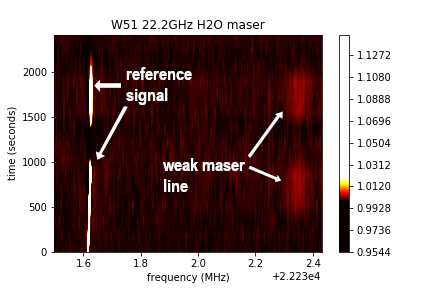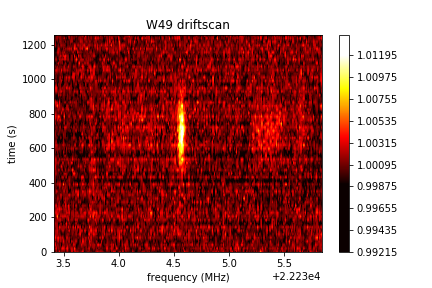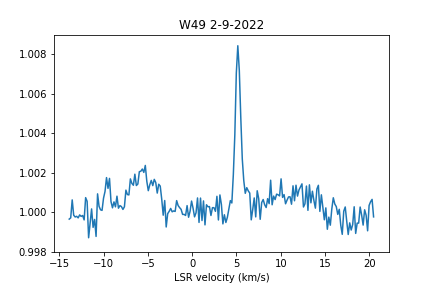detecting 22GHz H2O masers with a small dish
Eduard Mol
Eduard Mol
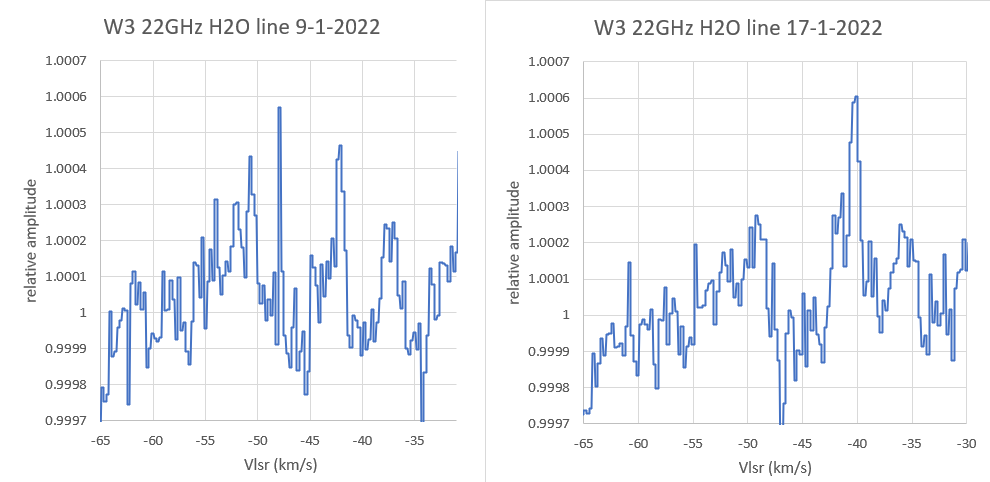

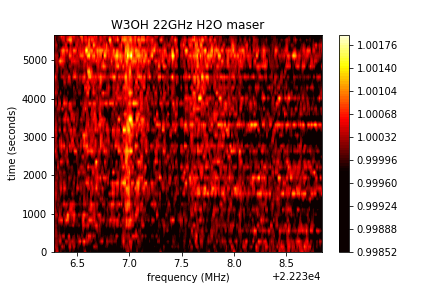
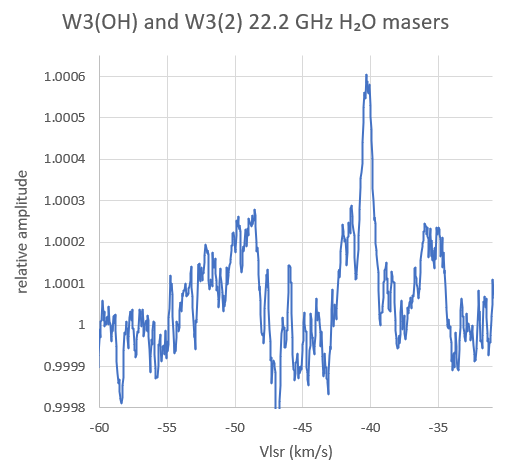
Wolfgang Herrmann
Eduard Mol
Maybe I could record spectra while repeatedly pointing the dish on-target and off-target. If the line only appears when the dish is pointed on-target, then it is very likely from W3(OH)/ W3.
Eduard Mol
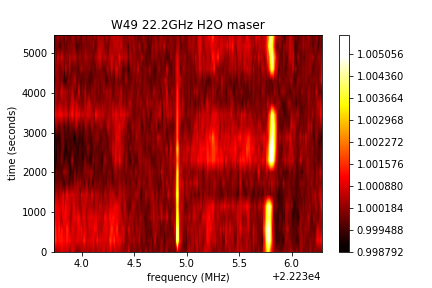
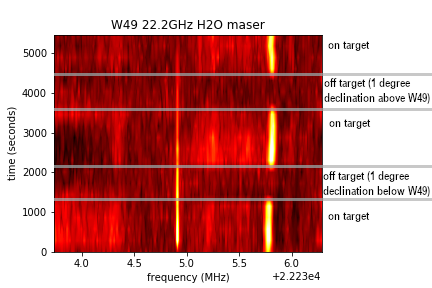
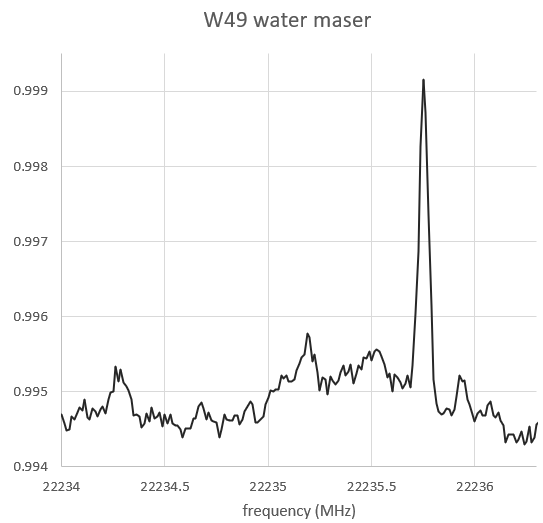
Job Geheniau
fasleitung3
Michiel Klaassen
--
--
You received this message because you are subscribed to the Google
Groups "Society of Amateur Radio Astronomers" group.
To post to this group, send email to sara...@googlegroups.com
To unsubscribe from this group, send email to
sara-list-...@googlegroups.com
For more options, visit this group at
http://groups.google.com/group/sara-list?hl=en
---
You received this message because you are subscribed to the Google Groups "Society of Amateur Radio Astronomers" group.
To unsubscribe from this group and stop receiving emails from it, send an email to sara-list+...@googlegroups.com.
To view this discussion on the web visit https://groups.google.com/d/msgid/sara-list/2e31154de831c921a1bf8e0776d829ef3fe8b271.camel%40googlemail.com.
Marcus D. Leech
Hi all,
After weeks of rain and fog we finally had some good weather yesterday. W3(OH) was at an unfavourable position in the sky (behind the house) when I had just set up my dish late in the morning, so I pointed my dish at W49 instead.W49 was about 40 degrees above the horizon in the southwest at that moment, well above the trees and buildings nearby. Spectra were recorded every 5 minutes. During the observation session the dish was pointed "off-target" two times (1 degree declination below and above the position of W49). "Dark" spectra for bandpass correction were recorded afterwards with the dish pointed at cold sky at an elevation of about 40 degrees. A heatmap of all the bandpass- corrected spectra recorded during the observation is shown below:
The narrow line at 22234.9 MHz is an artifact of the SDR. There is a strong line at 22235.75 MHz, which is not present in the spectra recorded off-target. This is a good indication that the line is indeed from W49. The frequency of the line shifted somewhat during the observation, probably due to frequency drifting of the LNB LO.
Finally, I averaged all the "on-target" spectra. The frequency axis was not converted to LSR velocity because of the large uncertainty in the frequency. The total integration time is about 1 hour. Besides the strong line at 22235.75 MHz there are hints of weaker lines at other frequencies as well.
Unfortunately I could not do observations of W3(OH) because it started to rain early in the evening. I will revisit W3(OH) another time.
best regards,Eduard
--
--
You received this message because you are subscribed to the Google
Groups "Society of Amateur Radio Astronomers" group.
To post to this group, send email to sara...@googlegroups.com
To unsubscribe from this group, send email to
sara-list-...@googlegroups.com
For more options, visit this group at
http://groups.google.com/group/sara-list?hl=en
---
You received this message because you are subscribed to the Google Groups "Society of Amateur Radio Astronomers" group.
To unsubscribe from this group and stop receiving emails from it, send an email to sara-list+...@googlegroups.com.
To view this discussion on the web visit https://groups.google.com/d/msgid/sara-list/fbb4d555-bf31-4780-abe7-0352d91d20c3n%40googlegroups.com.
eddiem...@gmail.com
Op 6 feb. 2022 om 20:54 heeft Marcus D. Leech <patchv...@gmail.com> het volgende geschreven:
To view this discussion on the web visit https://groups.google.com/d/msgid/sara-list/fda8dacd-d910-1846-870d-f4a6d14497d8%40gmail.com.
Eduard Mol
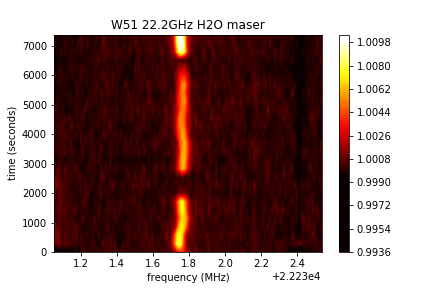
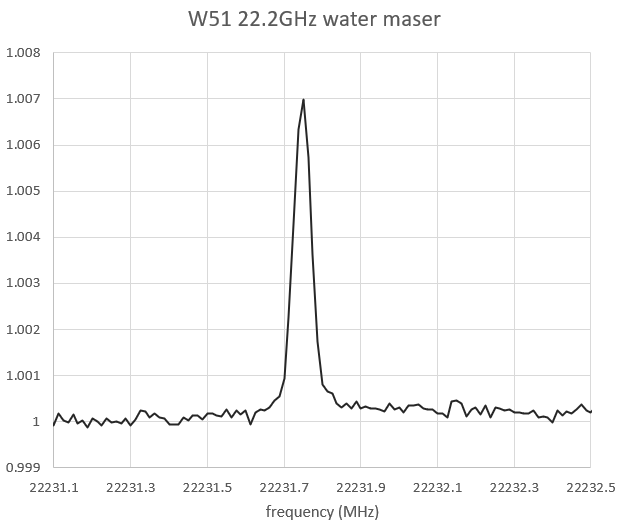
Job Geheniau
Eduard Mol
Job Geheniau
Op 8 feb. 2022 om 16:37 heeft Eduard Mol <eddiem...@gmail.com> het volgende geschreven:
Hi Job,
You received this message because you are subscribed to a topic in the Google Groups "Society of Amateur Radio Astronomers" group.
To unsubscribe from this topic, visit https://groups.google.com/d/topic/sara-list/TrZR8yCIWUE/unsubscribe.
To unsubscribe from this group and all its topics, send an email to sara-list+...@googlegroups.com.
To view this discussion on the web visit https://groups.google.com/d/msgid/sara-list/0ac708e1-981d-4575-8a04-44c8078d5b2cn%40googlegroups.com.
Eduard Mol

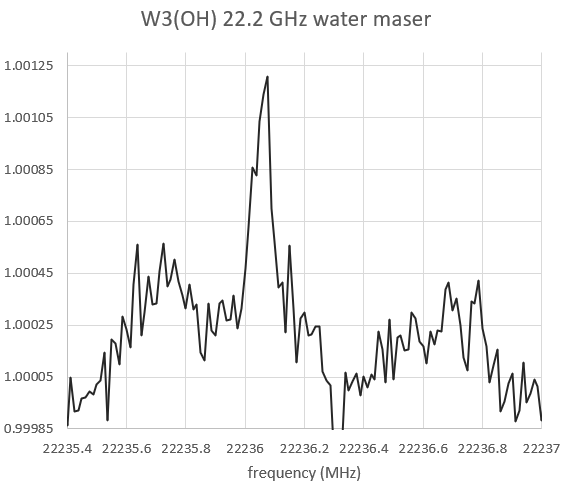
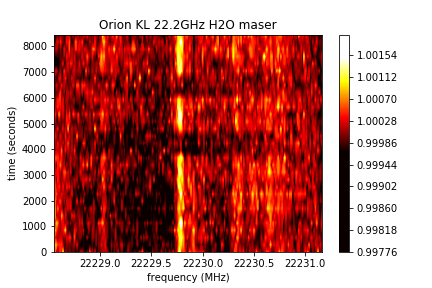
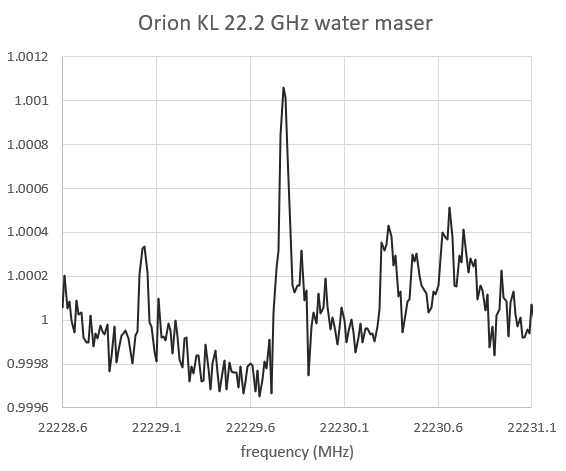
vk3...@gmail.com
Excellent work Eduard…really impressed.
Do you have any information on what you are using for 22.2 GHz receiver?
Cheers
Clint Jeffrey – VK3CSJ
ASV-RAS
From: sara...@googlegroups.com <sara...@googlegroups.com> On Behalf Of Eduard Mol
Sent: Tuesday, 15 February 2022 7:16 AM
To: Society of Amateur Radio Astronomers <sara...@googlegroups.com>
Subject: Re: [SARA] Re: detecting 22GHz H2O masers with a small dish
Hi all,
Last weekend I observed W3(OH) and another water maser source: Orion KL.
Here are the results from W3(OH):
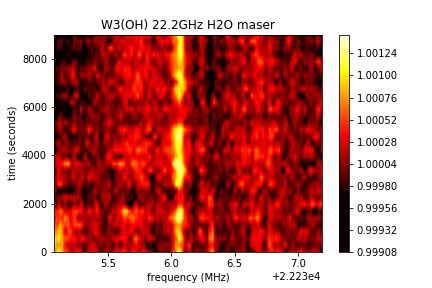
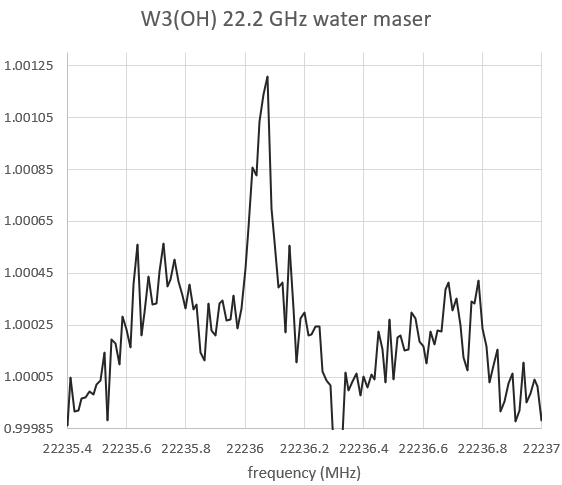
As can be seen the relatively strong peak at 22236 MHz disappeared when the dish was pointed away from the source. This is a good indication that W3(OH) is indeed detected.
Orion KL, a strong maser source inside the well-known Orion nebula, was also detected:
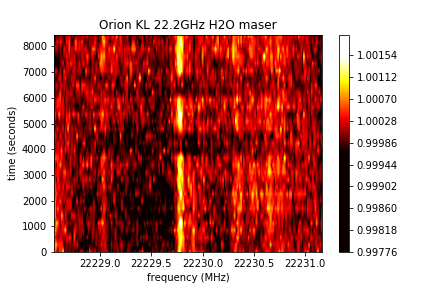

Besides the stronger signal at 22229.7 MHz there seem to be multiple weaker lines from this source.
I did notice that bandpass correction is very tricky, the spectra of W3(OH) and Orion KL shown here are not very flat. This is possibly due to varying amounts of water vapour in the telescope beam when it is tracking objects in the sky.
On Tuesday, 8 February 2022 at 17:12:46 UTC+1 jobge...@gmail.com wrote:
Thanks!
Op 8 feb. 2022 om 16:37 heeft Eduard Mol <eddiem...@gmail.com> het volgende geschreven:
Hi Job,
For target selection I used the Arcetri H2O maser catalog by Valdettaro et al. (2001), available on VizieR (https://vizier.cds.unistra.fr/viz-bin/VizieR-3?-source=J/A%2bA/368/845&-out.max=50&-out.form=HTML%20Table&-out.add=_r&-out.add=_RAJ,_DEJ&-sort=_r&-oc.form=sexa), and the search tool of the maser database MaserDB (https://maserdb.net/). However, water masers are highly variable over timescales of a few months to years, so the reported flux densities should be taken with some caution especially if the observations were done many years ago.
On Monday, 7 February 2022 at 22:33:53 UTC+1 jobge...@gmail.com wrote:
Nice Ed!
Short question,
Where do you get the 'objects' you want to observe?
Job
Op maandag 7 februari 2022 om 21:57:33 UTC+1 schreef eddiem...@gmail.com:
Today I pointed my dish at yet another star forming region: W51. A strong flare of the 22.2 GHz maser in this star forming region was reported in October 2021, it reached a flux density of 26200 Jy. (see ATel #15002: https://www.astronomerstelegram.org/?read=15002). the W51 water maser is therefore one of the most promising targets for detection with a small dish, especially if the flare is still going on right now.
Like during the observations of W49 last saturday, I pointed the dish 1 degree away from the target twice during the observation session. A strong line was detected at 22231.75 MHz, which was absent when the dish was pointed 1 degree away from the target. Towards the end of the observing session I noticed that the pointing was off by about 25 arcminutes, so I adjusted the position of the dish until the signal was at maximum strength. Despite the fact that the pointing was somewhat off during most of the observation session, the SNR is still much better than expected.
I had to stop my observations late in the afternoon due to the weather, so W3(OH) will have to wait for another time again...
Best regards,
Eduard
On Sunday, 6 February 2022 at 21:06:53 UTC+1 Eduard Mol wrote:
Hi Marcus,
I am using a Norsat 9000LD Ka band DRO LNB. It is not modified.
Best regards,
Eduard
Op 6 feb. 2022 om 20:54 heeft Marcus D. Leech <patchv...@gmail.com> het volgende geschreven:
On 2022-02-06 10:21, Eduard Mol wrote:
Hi all,
After weeks of rain and fog we finally had some good weather yesterday. W3(OH) was at an unfavourable position in the sky (behind the house) when I had just set up my dish late in the morning, so I pointed my dish at W49 instead.
W49 was about 40 degrees above the horizon in the southwest at that moment, well above the trees and buildings nearby. Spectra were recorded every 5 minutes. During the observation session the dish was pointed "off-target" two times (1 degree declination below and above the position of W49). "Dark" spectra for bandpass correction were recorded afterwards with the dish pointed at cold sky at an elevation of about 40 degrees. A heatmap of all the bandpass- corrected spectra recorded during the observation is shown below:
The narrow line at 22234.9 MHz is an artifact of the SDR. There is a strong line at 22235.75 MHz, which is not present in the spectra recorded off-target. This is a good indication that the line is indeed from W49. The frequency of the line shifted somewhat during the observation, probably due to frequency drifting of the LNB LO.
Finally, I averaged all the "on-target" spectra. The frequency axis was not converted to LSR velocity because of the large uncertainty in the frequency. The total integration time is about 1 hour. Besides the strong line at 22235.75 MHz there are hints of weaker lines at other frequencies as well.
Unfortunately I could not do observations of W3(OH) because it started to rain early in the evening. I will revisit W3(OH) another time.
best regards,
Eduard
Could you remind us of which LNB you're using, and whether you had to modify it?
On Thursday, 20 January 2022 at 17:51:26 UTC+1 Eduard Mol wrote:
Hi Wolfgang,
Thank you for your feedback. I will try wat you suggested next time when the weather improves.
Maybe I could record spectra while repeatedly pointing the dish on-target and off-target. If the line only appears when the dish is pointed on-target, then it is very likely from W3(OH)/ W3.Best regards,
Eduard
On Thursday, 20 January 2022 at 17:26:15 UTC+1 Wolfgang Herrmann wrote:
Hi Eduard,
I find it more likely that the line you have at 40 km/s is actually the line from W3OH which normally would be found at 49 km/s and that the difference is due to the uncertainty in frequency. The W3OH line is significantly stronger than the W3 line. What you could do to confirm the observations is to take a recording delliberately looking "off target".
Best regards,
Wolfgang
eddiem...@gmail.com schrieb am Mittwoch, 19. Januar 2022 um 20:44:20 UTC+1:
Hi all,
Despite the frequency drift problem I still decided to try detecting a water maser.
On January 9 the star forming region W3 was observed for 45 minutes. A second, 3 hours long observation was carried out on January 17. I have used my earlier measurements of the Eutelsat 7A satellite beacon to correct for the LO frequency offset. There is of course still uncertainty in the frequency due to the frequency drifting of the LO.
In the spectrum of January 9, one peak stood out at -42 km/s. There is a hint of some weaker peaks at -51 km/s and -37.5 km/s. The narrow spike at -48 km/s is an artifact of the SDR. The spectrum of January 17 has one obvious peak at -40 km/s, with possibly weaker peaks at -49 and -35.5 km/s. If these features are the same as the peaks in the spectrum of January 9, then there is a 2 km/s difference between the two spectra, possibly caused by frequency difting of the LO.
I also averaged the two results to get a (slightly) better SNR, accounting for a possible 2 km/s shift.
To view this discussion on the web visit https://groups.google.com/d/msgid/sara-list/63e519ca-161e-4148-a40d-398badf473a0n%40googlegroups.com.
eddiem...@gmail.com
Op 15 feb. 2022 om 14:18 heeft vk3...@gmail.com het volgende geschreven:
To view this discussion on the web visit https://groups.google.com/d/msgid/sara-list/063501d8226e%2478faf810%246af0e830%24%40gmail.com.
Eduard Mol

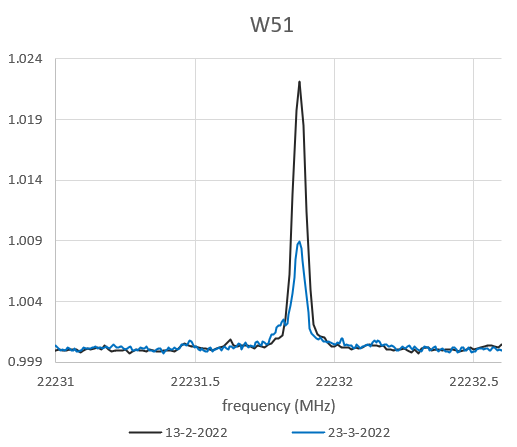
Eduard Mol
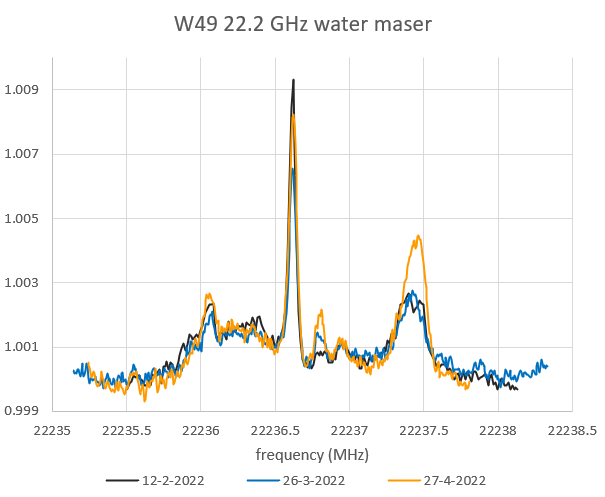
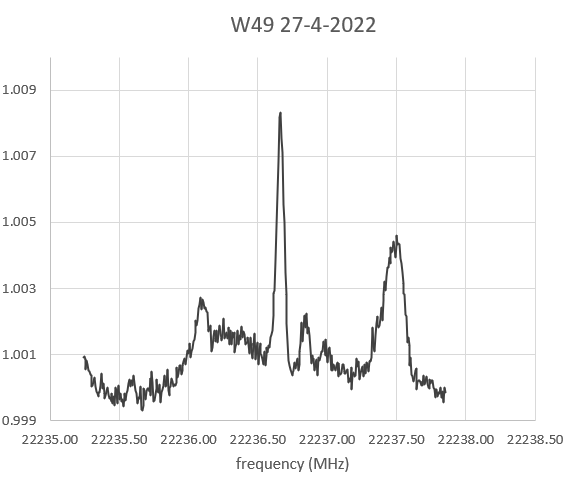
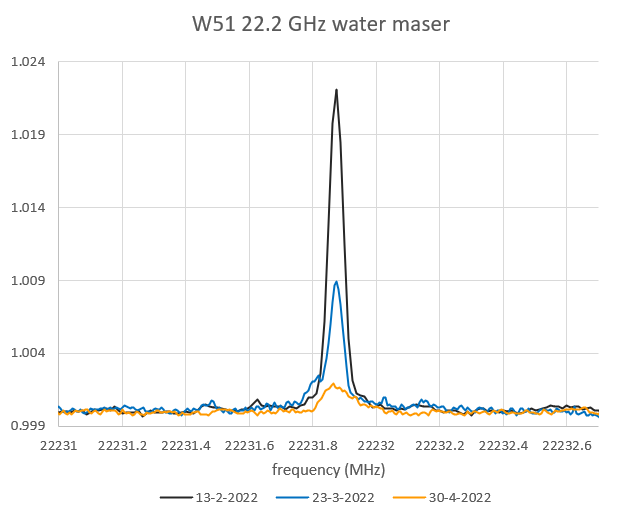
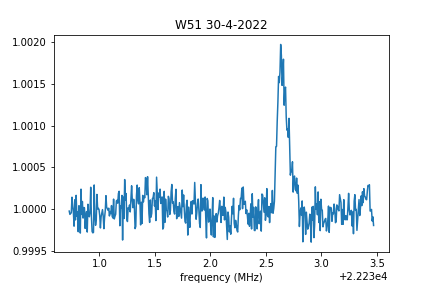
Job Geheniau
Op 30 apr. 2022 om 21:12 heeft Eduard Mol <eddiem...@gmail.com> het volgende geschreven:
Hi all,
It has been a month since the last observations, so I decided it was time to check W49 and W51 again.Like last month, the new observations were plotted over the earlier spectra. Since I still have no method to calibrate the frequency I just aligned the peaks. This is obviously not a great solution, so somewhere in the next few months we will try to generate a reference signal to correct for the frequency drift and offset.The main peak and some of the weaker peaks of W49 seem to have become stronger. However, it is unclear whether this increase is real or just a result of better observing conditions. On the other hand, it can be seen that the intensity of the peaks with respect to each other varies as well, which suggests that these changes are at least partially due to the intrinsic variability of the maser.
<W49_22GHz_3.png><W49_22GHz_2704.png>
The intensity of W51 seems to have dropped even further since last month. It seems unlikely that such a large (>10 fold) intensity change is simply a result of different observing conditions (e.g. temperature or moisture) or pointing, given that I always get roughly the same values when I point the dish at the sun or W49.
<W51_0222_0422a.png><W51_300422_spectrum.png>
To view this discussion on the web visit https://groups.google.com/d/msgid/sara-list/0cf28d01-c175-46a7-ab5e-bfe2f4374a1an%40googlegroups.com.
<W51_0222_0422a.png><W49_22GHz_2704.png><W49_22GHz_3.png><W51_300422_spectrum.png>
Eduard Mol

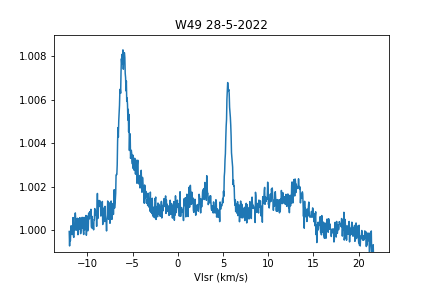
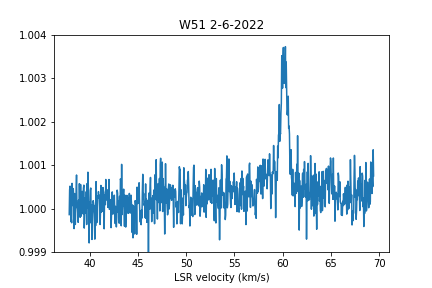
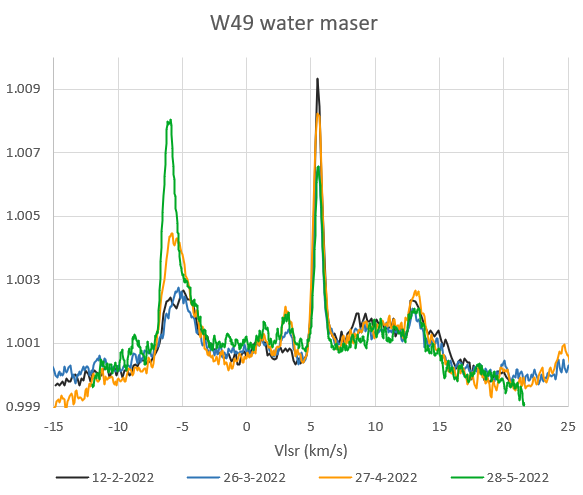
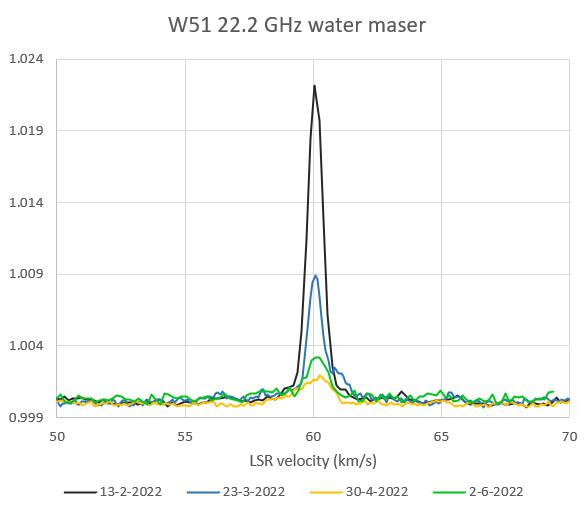
Eduard Mol
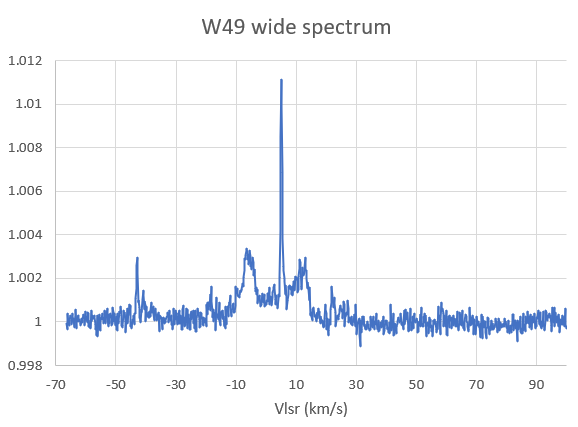
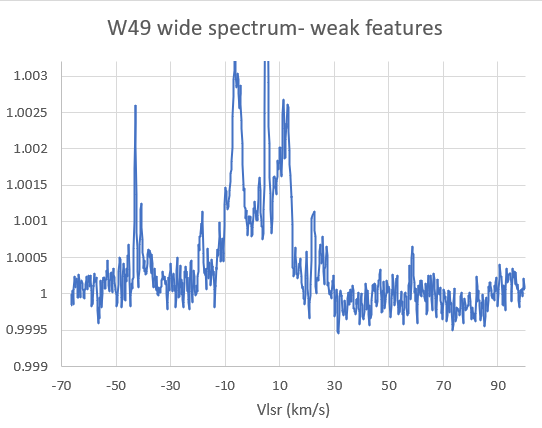
--
--
You received this message because you are subscribed to the Google
Groups "Society of Amateur Radio Astronomers" group.
To post to this group, send email to sara...@googlegroups.com
To unsubscribe from this group, send email to
sara-list-...@googlegroups.com
For more options, visit this group at
http://groups.google.com/group/sara-list?hl=en
---
You received this message because you are subscribed to the Google Groups "Society of Amateur Radio Astronomers" group.
To unsubscribe from this group and stop receiving emails from it, send an email to sara-list+...@googlegroups.com.
To view this discussion on the web visit https://groups.google.com/d/msgid/sara-list/7ffc5520-8a7a-4219-a0f4-8fa442349c4cn%40googlegroups.com.
Eduard Mol
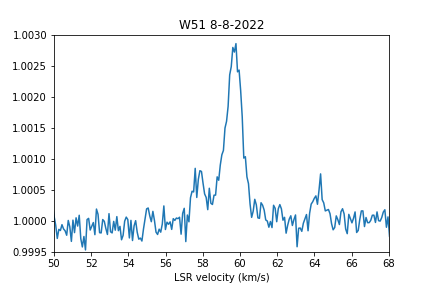
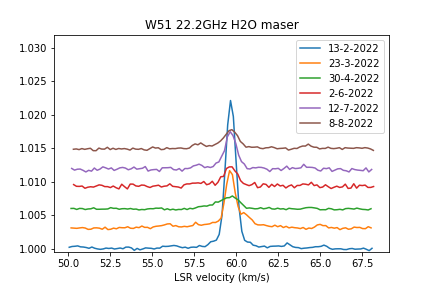

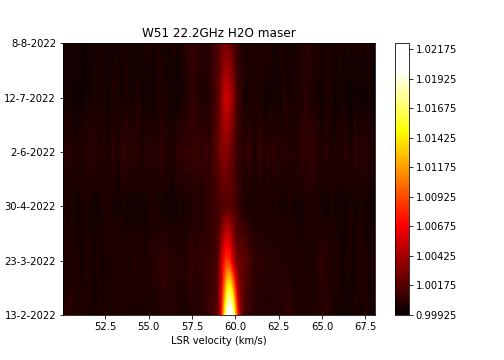
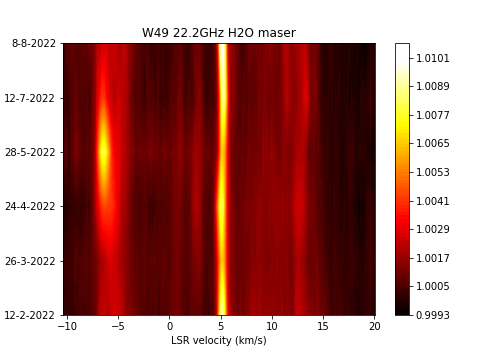
Steve Olney
Clint Jeffrey
This is amazing work by Eduard, unless I missed the email is there a write up of Eduard setup, I gather he’s using a small dish but that’s about all that is revealed in his posts below. Would be interested in some tech info on his 22.2 GHz receiver.
Cheers
Clint Jeffrey – VK3CSJ
Sent from Mail for Windows
From: Steve Olney
Sent: Friday, 26 August 2022 10:09 AM
To: Society of Amateur Radio Astronomers
Subject: Re: [SARA] Re: detecting 22GHz H2O masers with a small dish
Hi Eduard,
I've done an 'unroll' of your excellent series of posts about detecting H2O masers with a small dish. I used Latex to generate a PDF. I did it for my own reference - but perhaps you might be interested to have a look ? Let me know if you do and I will put it in the cloud and send a link.
Cheers Steve (HawkRAO)
On Thursday, August 11, 2022 at 3:06:51 AM UTC+10 eddiem...@gmail.com wrote:
Hi all,
A few nights ago I made a new spectrum of W51. It seems that this maser has not changed that much over the last few months.
Because the graphs with all the spectra plotted over each other are getting rather messy, I experimented with some other ways to visualise all the spectra collected in the last few months. One option is to make "stacking graphs". The shape of the peaks is nicely visible in this type of graph However, changes in the weaker peaks are not so easy to see, while the stronger peaks still overlap.
It is also possible to plot a "heatmap"-type graph, which has the intensity represented as a colour. What I like about this type of diagram is that changes in the peaks are very well displayed. On the other hand, the shape of the peaks is not well represented. To summarize, each type of graph has its own pro's and con's..
On Sun, 7 Aug 2022 at 12:22, Eduard Mol <eddiem...@gmail.com> wrote:
Hi all,
A few days ago Michiel Klaassen posted a 12 MHz wide spectrum of W49 over on the CAMRAS forum. Some masing clouds inside the W49 star forming region move at very high velocity, and their emission lines are therefore shifted by several MHz. The bandwidth of the SDRs Michiel and I use is limited to 2.5 MHz, so we often miss some of the highly red- and blueshifted peaks. To make a wider spectrum Michiel made a script for frequency-hopping, essentially taking several spectra at 2 MHz intervals and adding them together. Yesterday Itried something similar, making a 12 MHz wide spectrum composed of six spectra at 2 MHz intervals with 10 minutes integration time each.
The strongest emission is between -10 and +20 km/s, which is the part I have made spectra of before. However, there are several weaker peaks at -43, -41, -18, +22 and +58 km/s.
On Thu, 2 Jun 2022 at 21:42, Eduard Mol <eddiem...@gmail.com> wrote:
Hi all,
As mentioned in my post in Michiels thread on W49 yesterday I have been working on a reference signal. In this post I will share some of the details and results on this part of the project.
Recently I ordered a Leo Bodnar GPSDO. The output of this GPSDO is not a very "clean" signal, it has lots of harmonics at higher frequency. Now this was actually quite desirable for my project: when I attached a crude homemade 13.5mm dipole antenna to the output and set the GPSDO frequency output to 794.107143 MHz, I could detect the 28th harmonic at 22235 MHz!. The signal was of course very weak, but that was just wat I needed. However, I did not want this setup to generate lots of RFI at lower frequencies, so I built a small circular waveguide from a piece of 1cm copper tube. The inner diameter is 8mm, so the cutoff frequency should be around 11 GHz. In order to make this small antenna more directional I added a conical horn section with an opening of 35mm.
With this mounted on the dish I could finally generate a reference signal, which can be used for correcting the frequency drift and offset of the LNB
Now it is also possible to do LSR correction, which I did for my most recent observations of W49 and W51 (on May 28 and June 2 respectively).
For comparison I tried to plot my earlier observations of W49 and W51 on the Vlsr scale of my most recent observations. This was of course mostly guesswork, trying to match the peaks.
It can be seen that the broad peak at around -6km/s in the spectrum of W49 has clearly increased in intensity compared to the narrower peak at +5.5km/s W51 on the other hand does not seem to have changed very much since last month.
To view this discussion on the web visit https://groups.google.com/d/msgid/sara-list/6ddc8f34-d694-456b-84a6-fc9532b2e7c6n%40googlegroups.com.
Marcus D. Leech
This is amazing work by Eduard, unless I missed the email is there a write up of Eduard setup, I gather he’s using a small dish but that’s about all that is revealed in his posts below. Would be interested in some tech info on his 22.2 GHz receiver.
Cheers
Clint Jeffrey – VK3CSJ
there's no way we could point accurately enough anytime soon--until our Uni partners cough up $$ for better sensors.
But the surface is good to about 1mm RMS--at least it was at time of installation. Even if it has "drifted" a 12.8m dish
with only 30% efficiency would still be tremendous...
But for now, I'm fighting gremlins at 21cm...
To view this discussion on the web visit https://groups.google.com/d/msgid/sara-list/6D71F7AE-17D7-4A74-A757-214EFF6E9345%40hxcore.ol.
Steve Olney
Clint Jeffrey
G’day Steve...good to hear from you. Yes agree with your “unroll” as you say, which makes sense to me too.
Apart from the various charts and plots the only thing I see of technical value is the signal source he used for generating a reference. I was wondering if Eduard may have described the 22.2 GHz receiver arrangement, I read a reference to an SDR being used but there must be a Down Converter of some sort also being employed at the focal point, I would imagine...;)
Clint...
Sent from Mail for Windows
From: Steve Olney
Sent: Friday, 26 August 2022 11:25 AM
To: Society of Amateur Radio Astronomers
Subject: Re: [SARA] Re: detecting 22GHz H2O masers with a small dish
Hi Clint - I think all the required info is in Eduard's posts - which is why I did an 'unroll'. A great reference for myself as in the next 5 to 10 years we will need to 'downsize' and I have been pondering what could be done in a limited space. I reckon a 1m dish would be OK then.
Cheers
Steve (HawkRAO)
--
--
You received this message because you are subscribed to the Google
Groups "Society of Amateur Radio Astronomers" group.
To post to this group, send email to sara...@googlegroups.com
To unsubscribe from this group, send email to
sara-list-...@googlegroups.com
For more options, visit this group at
http://groups.google.com/group/sara-list?hl=en
---
You received this message because you are subscribed to the Google Groups "Society of Amateur Radio Astronomers" group.
To unsubscribe from this group and stop receiving emails from it, send an email to sara-list+...@googlegroups.com.
To view this discussion on the web visit https://groups.google.com/d/msgid/sara-list/6896b7ba-f5fe-4403-bc7a-0bc9129c9f22n%40googlegroups.com.
Steve Olney
Eduard Mol
--
--
You received this message because you are subscribed to the Google
Groups "Society of Amateur Radio Astronomers" group.
To post to this group, send email to sara...@googlegroups.com
To unsubscribe from this group, send email to
sara-list-...@googlegroups.com
For more options, visit this group at
http://groups.google.com/group/sara-list?hl=en
---
You received this message because you are subscribed to the Google Groups "Society of Amateur Radio Astronomers" group.
To unsubscribe from this group and stop receiving emails from it, send an email to sara-list+...@googlegroups.com.
To view this discussion on the web visit https://groups.google.com/d/msgid/sara-list/22b5cbce-77d7-4087-b049-ab5607d1e20an%40googlegroups.com.
Clint Jeffrey
Thanks Eduard....just found your article in the SARA Newsletter...all is explained...;)
Cheers...and great work!
Clint – VK3CSJ
Melbourne
From: Eduard Mol
Sent: Friday, 26 August 2022 5:23 PM
To: sara...@googlegroups.com
Subject: Re: [SARA] Re: detecting 22GHz H2O masers with a small dish
G'day Steve,
To view this discussion on the web visit https://groups.google.com/d/msgid/sara-list/CAFcm1Q7ekb%3D22hxy0UDY%3DZkXmjCck3%3DtCG3GsHHMkDKfoMYo9w%40mail.gmail.com.
Steve Olney
Steve Olney
Eduard Mol
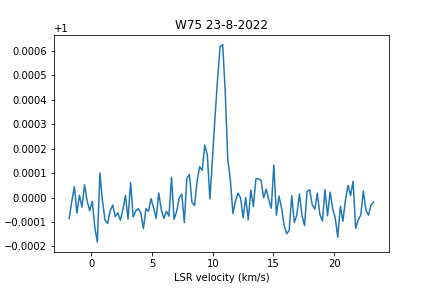
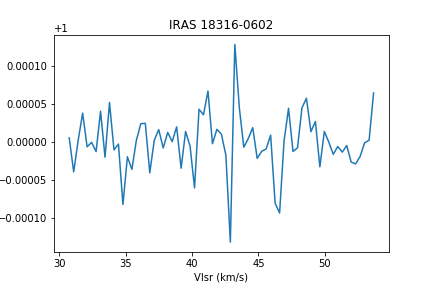

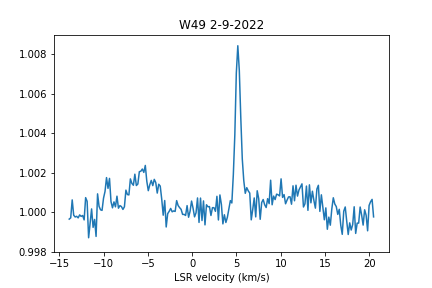
--
--
You received this message because you are subscribed to the Google
Groups "Society of Amateur Radio Astronomers" group.
To post to this group, send email to sara...@googlegroups.com
To unsubscribe from this group, send email to
sara-list-...@googlegroups.com
For more options, visit this group at
http://groups.google.com/group/sara-list?hl=en
---
You received this message because you are subscribed to the Google Groups "Society of Amateur Radio Astronomers" group.
To unsubscribe from this group and stop receiving emails from it, send an email to sara-list+...@googlegroups.com.
To view this discussion on the web visit https://groups.google.com/d/msgid/sara-list/4e3b7c1f-96b9-49b9-92eb-91675761ca92n%40googlegroups.com.
Dennis Spender
To view this discussion on the web visit https://groups.google.com/d/msgid/sara-list/CAFcm1Q65eKP5gSOY9pzkGG520uYQQ97scLpVrhzpc%3DYm_zJz5g%40mail.gmail.com.
989-245-4274C
Stephen Thornber
On 03 Sep 2022, at 13:45, Dennis Spender <dwsp...@gmail.com> wrote:
Please forgive me for such a juvenile question as this; I’m new to the list and topic of RA. What is a maser? Reading the posts I get the sense it is a general term for a characteristic of cosmic atoms you are searching for.Dennis
On Sat, Sep 3, 2022 at 7:27 AM Eduard Mol <eddiem...@gmail.com> wrote:
Hi all,In the last few weeks I did quite a few observation projects, and in this post I will share the results.First of all, I tried to detect OH 43.8-0.13, but unfortunately the result was negative. This maser is probably not strong enough at the moment.The source W75 was successfully detected with 80 minutes of integration time. My earlier attempt to detect it in March was unsuccessful, so the maser must have become stronger since then.
<W75_230822x.png>I attempted to detect IRAS 18316-0602 on the evenings of August 29 and 31 and September 2. Shown below is the averaged spectrum from these three observing sessions, the total integration time is about five and a half hours. It seems that this source is rather weak at the moment. A small peak was detected near the expected velocity of 42.5 km/s, but this peak is just barely above the noise and right next to the "dip" from the central spike of the SDR spectrum. I therefore suspect that it may just be an artifact.
<G25possiblesignal.png>Finally, a driftscan of W49 was made. Despite the short integration time (3 minutes) W49 was clearly detected. It should therefore be possible to detect the strongest water masers (or atleast W49) without a tracking mount. The SNR could be improved by averaging the results from multiple transits.
<W49driftscanplot1.png><W49driftresult1.png>Best regards,Eduard
To view this discussion on the web visit https://groups.google.com/d/msgid/sara-list/CAG%3DXrMxGdfQjYZDvVtiMyhyEFDXUnCW6%2BLL45QXgOtZ5W9aaRQ%40mail.gmail.com.
fasleitung3
fasleitung3
Finally, a driftscan of W49 was made. Despite the short integration time (3 minutes) W49 was clearly detected. It should therefore be possible to detect the strongest water masers (or atleast W49) without a tracking mount. The SNR could be improved by averaging the results from multiple transits.Best regards,Eduard
Dennis Spender
--
--
You received this message because you are subscribed to the Google
Groups "Society of Amateur Radio Astronomers" group.
To post to this group, send email to sara...@googlegroups.com
To unsubscribe from this group, send email to
sara-list-...@googlegroups.com
For more options, visit this group at
http://groups.google.com/group/sara-list?hl=en
---
You received this message because you are subscribed to the Google Groups "Society of Amateur Radio Astronomers" group.
To unsubscribe from this group and stop receiving emails from it, send an email to sara-list+...@googlegroups.com.
To view this discussion on the web visit https://groups.google.com/d/msgid/sara-list/737be2a47cc5548a3b3915748a84268023ecaf69.camel%40googlemail.com.
989-245-4274C
Eduard Mol
--
--
You received this message because you are subscribed to the Google
Groups "Society of Amateur Radio Astronomers" group.
To post to this group, send email to sara...@googlegroups.com
To unsubscribe from this group, send email to
sara-list-...@googlegroups.com
For more options, visit this group at
http://groups.google.com/group/sara-list?hl=en
---
You received this message because you are subscribed to the Google Groups "Society of Amateur Radio Astronomers" group.
To unsubscribe from this group and stop receiving emails from it, send an email to sara-list+...@googlegroups.com.
To view this discussion on the web visit https://groups.google.com/d/msgid/sara-list/9f092c9f0a420e4041c2ee259e35b1755b529db6.camel%40googlemail.com.
Eduard Mol
You received this message because you are subscribed to a topic in the Google Groups "Society of Amateur Radio Astronomers" group.
To unsubscribe from this topic, visit https://groups.google.com/d/topic/sara-list/TrZR8yCIWUE/unsubscribe.
To unsubscribe from this group and all its topics, send an email to sara-list+...@googlegroups.com.
To view this discussion on the web visit https://groups.google.com/d/msgid/sara-list/CAG%3DXrMzGQZXKRwNdCG5ds7MO9Q5KJ%3DUQmva9zqWh%2BGUf8TRhFw%40mail.gmail.com.
Dennis Spender
To view this discussion on the web visit https://groups.google.com/d/msgid/sara-list/CAFcm1Q7-UwTbs8nuZrjcbXajbJ_5b98-o-Tu2q%3DtTGf_CmCmrQ%40mail.gmail.com.
989-245-4274C
Marcus D. Leech
There are a bunch of astronomical maser lines, including two different lines caused by Methanol masering--again mostlyGreat. Thanks.
in star-forming regions, and pumped by ultraviolet as far as I know.
In addition to maser lines, there are an extensive pantheon of emission lines created by all kinds of physics both
in molecules and individual atoms. Many of them are too weak to be observed by an amateur observatory, but some
of them, most notably neutral hydrogen, are quite bright.
To view this discussion on the web visit https://groups.google.com/d/msgid/sara-list/CAG%3DXrMwfaxwQ4O8%2BEq3O0NnVL6AjL%2B2WW64-jeVa4jd0eKUcpQ%40mail.gmail.com.
fasleitung3
Dimitry UA3AVR
Captain Anne Flint
--
--
You received this message because you are subscribed to the Google
Groups "Society of Amateur Radio Astronomers" group.
To post to this group, send email to sara...@googlegroups.com
To unsubscribe from this group, send email to
sara-list-...@googlegroups.com
For more options, visit this group at
http://groups.google.com/group/sara-list?hl=en
---
You received this message because you are subscribed to the Google Groups "Society of Amateur Radio Astronomers" group.
To unsubscribe from this group and stop receiving emails from it, send an email to sara-list+...@googlegroups.com.
To view this discussion on the web visit https://groups.google.com/d/msgid/sara-list/19c59a3a-698c-48a7-81ca-47a14da0fe9bn%40googlegroups.com.
Dimitry UA3AVR
Eduard Mol
--
--
You received this message because you are subscribed to the Google
Groups "Society of Amateur Radio Astronomers" group.
To post to this group, send email to sara...@googlegroups.com
To unsubscribe from this group, send email to
sara-list-...@googlegroups.com
For more options, visit this group at
http://groups.google.com/group/sara-list?hl=en
---
You received this message because you are subscribed to the Google Groups "Society of Amateur Radio Astronomers" group.
To unsubscribe from this group and stop receiving emails from it, send an email to sara-list+...@googlegroups.com.
To view this discussion on the web visit https://groups.google.com/d/msgid/sara-list/19c59a3a-698c-48a7-81ca-47a14da0fe9bn%40googlegroups.com.
Dimitry UA3AVR
Eduard Mol

To view this discussion on the web visit https://groups.google.com/d/msgid/sara-list/fbbdc7ee-5db5-4823-ad1d-d4d2bfe4761an%40googlegroups.com.
Dimitry UA3AVR
Eduard Mol
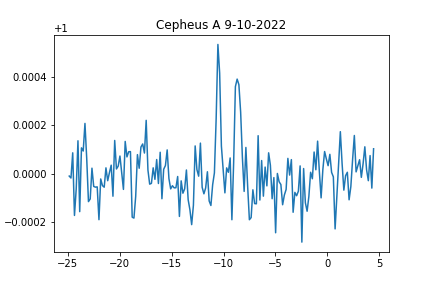
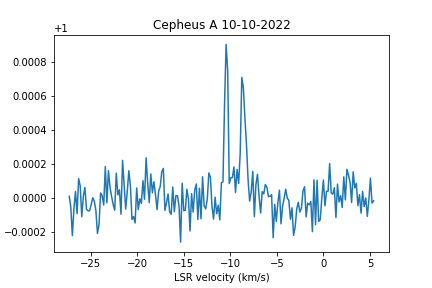
You received this message because you are subscribed to a topic in the Google Groups "Society of Amateur Radio Astronomers" group.
To unsubscribe from this topic, visit https://groups.google.com/d/topic/sara-list/TrZR8yCIWUE/unsubscribe.
To unsubscribe from this group and all its topics, send an email to sara-list+...@googlegroups.com.
To view this discussion on the web visit https://groups.google.com/d/msgid/sara-list/662bdef2-08d4-4437-9db5-3ee6ee0b179cn%40googlegroups.com.
Anthony
To view this discussion on the web visit https://groups.google.com/d/msgid/sara-list/CAFcm1Q4mmh%2B7tnByrotqA%3DUQist%3DXpZcLKx40u8aCLF7A7AW8Q%40mail.gmail.com.
Job Geheniau
Nice results.
I love to see how we as amateurs push the limits of the equipment we work with!
Fine hobby despite the hardware (for my part currently) sometimes failing. Giving up is not an option :-). !
Congratulations!!!
We'll keep in touch and I'll drop by in the (short) term to do a measurement with your equipment regarding my Nooelec SmartSDR.
Greetings Job
Dimitry Fedorov
To view this discussion on the web visit https://groups.google.com/d/msgid/sara-list/d0d3a38b-3837-48f7-915a-39a824d692cfn%40googlegroups.com.
Eduard Mol
To view this discussion on the web visit https://groups.google.com/d/msgid/sara-list/CAKU65Txu5S0U-MU0AZB%2B-BRGfNB4ootosGKXHbgs599Mz8Q7MQ%40mail.gmail.com.
Eduard Mol
To view this discussion on the web visit https://groups.google.com/d/msgid/sara-list/CAOMYq1cKzWHOyT5khk-8ji4yRKXmX4KrnpaXRHAnKG2KNkStiQ%40mail.gmail.com.
Anthony
To view this discussion on the web visit https://groups.google.com/d/msgid/sara-list/CAFcm1Q6N0pKkfgLGYGPBW%2BzEL%2BL9_--36_KdG_sDo0bHphz0Cg%40mail.gmail.com.
Dimitry UA3AVR
Jim Abshier
Does anyone know if the July-August SARA Journal has been published. I
have not received a notification with the link to it.
Jim Abshier
On 10/17/22 2:27 AM, Eduard Mol wrote:
> Hi Anthony,
>
> I am using a Norsat 9000LD Ka band LNB with a homemade horn antenna,
> and a Nooelec NeSDR XTR receiver. The setup is described in more
> detail in the first few posts. There is also an article about this
> project in the July- August SARA journal.
>
>
> On Sun, 16 Oct 2022 at 22:12, Anthony <itpart...@gmail.com
> <mailto:itpart...@gmail.com>> wrote:
>
> Hi Eduard,
>
> Congratulations! I may have asked this before and pardon me if I
> have, what type of LNA, BPF, are you using?
>
>
> On Sun, Oct 16, 2022 at 3:34 PM Eduard Mol <eddiem...@gmail.com
> <mailto:eddiem...@gmail.com>> wrote:
>
> Hi all,
> Last week the water maser in the star forming region Cepheus A
> was successfully observed. The first successful observation
> was done on the evening of October 9. Two weak peaks were
> detected very close to the expected LSR velocity of -10 km/s.
> The integration time was approximately 60 minutes. The
> observation was repeated on October 10; this time the peaks
> were a bit stronger and the SNR was better as well. This could
> be due to better observing conditions or more accurate pointing.
> Cepheus A is the sixth water maser source observed with the 1-
> metre "mini maser telescope", the other sources are W49, W51,
> W3, Orion KL and W75N. It seems that there are more than a few
> sources detectable at 22.2 GHz with relatively modest equipment.
>
>
>
>
> On Sun, 9 Oct 2022 at 14:53, Dimitry UA3AVR
> <ua3avr...@gmail.com <mailto:ua3avr...@gmail.com>> wrote:
>
> Well done, Eduard, congrats! I did note the W3(OH) object
> emits the H20 radiation too. Hope to see these line in future.
>
> воскресенье, 9 октября 2022 г. в 13:00:16 UTC+3,
> Hi all,
>
> Last night I observed the W3 region again. There are
> two water maser sources in this region; W3(OH) and
> W3(2). W3(OH) is usually the strongest of the two.
> MaserDB lists LSR velocities of -48 to -50 km/s for
> the main peak of W3(OH) and -35 to -41 km/s for W3(2).
> Last winter I already did some observations of W3, but
> since I had no frequency reference it was not possible
> to calculate LSR velocities and figure out whether the
> detected lines belonged to W3(OH) or W3(2).
> I just processed the data from last night's
> observation session, and to my surprise there is no
> signal at the expected velocity of W3(OH). Instead,
> there are three peaks at -37, -39 and -41 km/s, which
> is more consistent with W3(2). Alternatively, the
> frequency correction or LSR correction could be off.
> However, W51m was observed as well yesterday as part
> of my W49/ W51 monthly observation program, and the
> peak velocity of 58 km/s is consistent with my earlier
> observations and with the LSR velocities listed in
> maserDB. So a mistake in the frequency or velocity
> correction seems less likely. I will try to repeat my
> observations later this month to see what is going on
> here...
> --
> --
> You received this message because you are
> subscribed to the Google
> Groups "Society of Amateur Radio Astronomers" group.
> To post to this group, send email to
> sara...@googlegroups.com
> To unsubscribe from this group, send email to
> sara-list-...@googlegroups.com
> For more options, visit this group at
> http://groups.google.com/group/sara-list?hl=en
> ---
> You received this message because you are
> subscribed to the Google Groups "Society of
> Amateur Radio Astronomers" group.
> To unsubscribe from this group and stop receiving
> emails from it, send an email to
> sara-list+...@googlegroups.com.
>
> To view this discussion on the web visit
> <https://groups.google.com/d/msgid/sara-list/fbbdc7ee-5db5-4823-ad1d-d4d2bfe4761an%40googlegroups.com?utm_medium=email&utm_source=footer>.
> --
> --
> You received this message because you are subscribed to
> the Google
> Groups "Society of Amateur Radio Astronomers" group.
> To post to this group, send email to
> <mailto:sara-list-...@googlegroups.com>
> http://groups.google.com/group/sara-list?hl=en
> ---
> You received this message because you are subscribed to a
> topic in the Google Groups "Society of Amateur Radio
> Astronomers" group.
> To unsubscribe from this topic, visit
> https://groups.google.com/d/topic/sara-list/TrZR8yCIWUE/unsubscribe.
> To unsubscribe from this group and all its topics, send an
> email to sara-list+...@googlegroups.com
> <https://groups.google.com/d/msgid/sara-list/662bdef2-08d4-4437-9db5-3ee6ee0b179cn%40googlegroups.com?utm_medium=email&utm_source=footer>.
> --
> --
> You received this message because you are subscribed to the Google
> Groups "Society of Amateur Radio Astronomers" group.
> To post to this group, send email to
> <mailto:sara-list-...@googlegroups.com>
> http://groups.google.com/group/sara-list?hl=en
> ---
> You received this message because you are subscribed to the
> Google Groups "Society of Amateur Radio Astronomers" group.
> To unsubscribe from this group and stop receiving emails from
> it, send an email to sara-list+...@googlegroups.com
> <https://groups.google.com/d/msgid/sara-list/CAFcm1Q4mmh%2B7tnByrotqA%3DUQist%3DXpZcLKx40u8aCLF7A7AW8Q%40mail.gmail.com?utm_medium=email&utm_source=footer>.
> --
> --
> You received this message because you are subscribed to the Google
> Groups "Society of Amateur Radio Astronomers" group.
> To post to this group, send email to sara...@googlegroups.com
> <mailto:sara-list-...@googlegroups.com>
> http://groups.google.com/group/sara-list?hl=en
> ---
> You received this message because you are subscribed to the Google
> Groups "Society of Amateur Radio Astronomers" group.
> To unsubscribe from this group and stop receiving emails from it,
> send an email to sara-list+...@googlegroups.com
> <https://groups.google.com/d/msgid/sara-list/CAKU65Txu5S0U-MU0AZB%2B-BRGfNB4ootosGKXHbgs599Mz8Q7MQ%40mail.gmail.com?utm_medium=email&utm_source=footer>.
> --
> --
> You received this message because you are subscribed to the Google
> Groups "Society of Amateur Radio Astronomers" group.
> To post to this group, send email to sara...@googlegroups.com
> To unsubscribe from this group, send email to
> sara-list-...@googlegroups.com
> For more options, visit this group at
> http://groups.google.com/group/sara-list?hl=en
> ---
> You received this message because you are subscribed to the Google
> Groups "Society of Amateur Radio Astronomers" group.
> To unsubscribe from this group and stop receiving emails from it, send
> an email to sara-list+...@googlegroups.com
> <https://groups.google.com/d/msgid/sara-list/CAFcm1Q6N0pKkfgLGYGPBW%2BzEL%2BL9_--36_KdG_sDo0bHphz0Cg%40mail.gmail.com?utm_medium=email&utm_source=footer>.
Anthony
To view this discussion on the web visit https://groups.google.com/d/msgid/sara-list/de5678fc-164c-8131-a57b-9ab9ea3f52ba%40ameritech.net.
Dr. Rich Russel
Anthony
Jim Abshier
June 2022.
Jim Abshier
On 10/17/22 3:21 PM, 'Dr. Rich Russel' via Society of Amateur Radio
> >
> > Hi Eduard,
> >
> > Congratulations! I may have asked this before and pardon me if I
> > have, what type of LNA, BPF, are you using?
> >
> >
> > On Sun, Oct 16, 2022 at 3:34 PM Eduard Mol
> <eddiem...@gmail.com <mailto:eddiem...@gmail.com>
> >
> > Well done, Eduard, congrats! I did note the W3(OH)
> object
> > emits the H20 radiation too. Hope to see these line
> in future.
> >
> > воскресенье, 9 октября 2022 г. в 13:00:16 UTC+3,
> > eddiem...@gmail.com <mailto:eddiem...@gmail.com>
> >
> > OK, Eduard, thanks ...
> > ... a rough estimate is what of needed to know
> > detection chances (and keeping in mind the
> > variability). The maser DB is already accessible
> > again.
> >
> > воскресенье, 4 сентября 2022 г. в 23:15:47
> UTC+3,
> > Hi Dimitry,
> >
> > For some reason I could not access maserDB
> > today, maybe it is temporarily offline,
> but if
> > I remember correctly the flux densities
> > reported there were in the order of
> thousands
> > to tens of thousands Jansky.
> > Actually determining the flux density
> from my
> > own measurements is difficult, because I
> have
> > no calibration source and variations in the
> > amount of water vapor in the atmosphere have
> > to be accounted for. I did make a rough
> > guesstimate of the flux of W49 from my own
> > measurements, which was around 26000 Jy, so
> > quite strong indeed.
> >
> > Op za 3 sep. 2022 om 21:14 schreef Dimitry
> > UA3AVR <ua3avr...@gmail.com
> > To unsubscribe from this group, send
> email to
> > sara-list-...@googlegroups.com
> <mailto:sara-list-...@googlegroups.com>
> > For more options, visit this group at
> > http://groups.google.com/group/sara-list?hl=en
> > ---
> > You received this message because
> you are
> > subscribed to the Google Groups "Society
> > of Amateur Radio Astronomers" group.
> > To unsubscribe from this group and stop
> > receiving emails from it, send an
> email to
> > sara-list+...@googlegroups.com
> > To view this discussion on the web visit
> >
> >
> <https://groups.google.com/d/msgid/sara-list/19c59a3a-698c-48a7-81ca-47a14da0fe9bn%40googlegroups.com?utm_medium=email&utm_source=footer>.
> >
> > --
> > --
> > You received this message because you are
> > subscribed to the Google
> > Groups "Society of Amateur Radio
> Astronomers" group.
> > To post to this group, send email to
> > To unsubscribe from this group, send email to
> > sara-list-...@googlegroups.com
> <mailto:sara-list-...@googlegroups.com>
> > For more options, visit this group at
> > http://groups.google.com/group/sara-list?hl=en
> > ---
> > You received this message because you are
> > subscribed to the Google Groups "Society of
> > Amateur Radio Astronomers" group.
> > To unsubscribe from this group and stop
> receiving
> > emails from it, send an email to
> > sara-list+...@googlegroups.com
> > To view this discussion on the web visit
> >
> >
> <https://groups.google.com/d/msgid/sara-list/fbbdc7ee-5db5-4823-ad1d-d4d2bfe4761an%40googlegroups.com?utm_medium=email&utm_source=footer>.
> >
> > --
> > --
> > You received this message because you are subscribed to
> > the Google
> > Groups "Society of Amateur Radio Astronomers" group.
> > To post to this group, send email to
> > sara...@googlegroups.com <mailto:sara...@googlegroups.com>
> > To unsubscribe from this group, send email to
> > sara-list-...@googlegroups.com
> <mailto:sara-list-...@googlegroups.com>
> > For more options, visit this group at
> > http://groups.google.com/group/sara-list?hl=en
> > ---
> > You received this message because you are subscribed
> to a
> > topic in the Google Groups "Society of Amateur Radio
> > Astronomers" group.
> > To unsubscribe from this topic, visit
> > https://groups.google.com/d/topic/sara-list/TrZR8yCIWUE/unsubscribe.
> > To unsubscribe from this group and all its topics,
> send an
> > email to sara-list+...@googlegroups.com
> > <mailto:sara-list+...@googlegroups.com
> <mailto:sara-list%2Bunsu...@googlegroups.com>>.
> >
> https://groups.google.com/d/msgid/sara-list/662bdef2-08d4-4437-9db5-3ee6ee0b179cn%40googlegroups.com
> >
> <https://groups.google.com/d/msgid/sara-list/662bdef2-08d4-4437-9db5-3ee6ee0b179cn%40googlegroups.com?utm_medium=email&utm_source=footer>.
> >
> > --
> > --
> > You received this message because you are subscribed to
> the Google
> > Groups "Society of Amateur Radio Astronomers" group.
> > To post to this group, send email to
> > sara...@googlegroups.com <mailto:sara...@googlegroups.com>
> > To unsubscribe from this group, send email to
> > sara-list-...@googlegroups.com
> <mailto:sara-list-...@googlegroups.com>
> > For more options, visit this group at
> > http://groups.google.com/group/sara-list?hl=en
> > ---
> > You received this message because you are subscribed to the
> > Google Groups "Society of Amateur Radio Astronomers" group.
> > To unsubscribe from this group and stop receiving emails
> from
> > it, send an email to
> sara-list+...@googlegroups.com
> > <mailto:sara-list+...@googlegroups.com
> <mailto:sara-list%2Bunsu...@googlegroups.com>>.
> >
> https://groups.google.com/d/msgid/sara-list/CAFcm1Q4mmh%2B7tnByrotqA%3DUQist%3DXpZcLKx40u8aCLF7A7AW8Q%40mail.gmail.com
> >
> <https://groups.google.com/d/msgid/sara-list/CAFcm1Q4mmh%2B7tnByrotqA%3DUQist%3DXpZcLKx40u8aCLF7A7AW8Q%40mail.gmail.com?utm_medium=email&utm_source=footer>.
> >
> > --
> > --
> > You received this message because you are subscribed to the
> > Groups "Society of Amateur Radio Astronomers" group.
> > To post to this group, send email to
> sara...@googlegroups.com <mailto:sara...@googlegroups.com>
> > To unsubscribe from this group, send email to
> > sara-list-...@googlegroups.com
> <mailto:sara-list-...@googlegroups.com>
> > For more options, visit this group at
> > http://groups.google.com/group/sara-list?hl=en
> > ---
> > You received this message because you are subscribed to the
> > Groups "Society of Amateur Radio Astronomers" group.
> > To unsubscribe from this group and stop receiving emails
> from it,
> > send an email to sara-list+...@googlegroups.com
> > <mailto:sara-list+...@googlegroups.com
> <mailto:sara-list%2Bunsu...@googlegroups.com>>.
> >
> https://groups.google.com/d/msgid/sara-list/CAKU65Txu5S0U-MU0AZB%2B-BRGfNB4ootosGKXHbgs599Mz8Q7MQ%40mail.gmail.com
> >
> <https://groups.google.com/d/msgid/sara-list/CAKU65Txu5S0U-MU0AZB%2B-BRGfNB4ootosGKXHbgs599Mz8Q7MQ%40mail.gmail.com?utm_medium=email&utm_source=footer>.
> >
> > --
> > --
> > You received this message because you are subscribed to the Google
> > Groups "Society of Amateur Radio Astronomers" group.
> > To post to this group, send email to sara...@googlegroups.com
> > To unsubscribe from this group, send email to
> > sara-list-...@googlegroups.com
> <mailto:sara-list-...@googlegroups.com>
> > For more options, visit this group at
> > http://groups.google.com/group/sara-list?hl=en
> > ---
> > You received this message because you are subscribed to the Google
> > Groups "Society of Amateur Radio Astronomers" group.
> > To unsubscribe from this group and stop receiving emails from
> it, send
> > an email to sara-list+...@googlegroups.com
> > <mailto:sara-list+...@googlegroups.com
> <mailto:sara-list%2Bunsu...@googlegroups.com>>.
> >
> https://groups.google.com/d/msgid/sara-list/CAFcm1Q6N0pKkfgLGYGPBW%2BzEL%2BL9_--36_KdG_sDo0bHphz0Cg%40mail.gmail.com
>
> >
> <https://groups.google.com/d/msgid/sara-list/CAFcm1Q6N0pKkfgLGYGPBW%2BzEL%2BL9_--36_KdG_sDo0bHphz0Cg%40mail.gmail.com?utm_medium=email&utm_source=footer>.
>
> --
> --
> You received this message because you are subscribed to the Google
> Groups "Society of Amateur Radio Astronomers" group.
> To post to this group, send email to sara...@googlegroups.com
> To unsubscribe from this group, send email to
> sara-list-...@googlegroups.com
> <mailto:sara-list-...@googlegroups.com>
> For more options, visit this group at
> http://groups.google.com/group/sara-list?hl=en
> ---
> You received this message because you are subscribed to the Google
> Groups "Society of Amateur Radio Astronomers" group.
> To unsubscribe from this group and stop receiving emails from it,
> send an email to sara-list+...@googlegroups.com
>
> --
> --
> You received this message because you are subscribed to the Google
> Groups "Society of Amateur Radio Astronomers" group.
> To post to this group, send email to sara...@googlegroups.com
> To unsubscribe from this group, send email to
> sara-list-...@googlegroups.com
> For more options, visit this group at
> http://groups.google.com/group/sara-list?hl=en
> ---
> You received this message because you are subscribed to the Google
> Groups "Society of Amateur Radio Astronomers" group.
> To unsubscribe from this group and stop receiving emails from it, send
> https://groups.google.com/d/msgid/sara-list/CAKU65TyKArchCauLOSQ2WwZPwmE%3DW-L_3q2pTnKjcinLCL2gJw%40mail.gmail.com
> <https://groups.google.com/d/msgid/sara-list/CAKU65TyKArchCauLOSQ2WwZPwmE%3DW-L_3q2pTnKjcinLCL2gJw%40mail.gmail.com?utm_medium=email&utm_source=footer>.
> --
> You received this message because you are subscribed to the Google
> Groups "Society of Amateur Radio Astronomers" group.
> To post to this group, send email to sara...@googlegroups.com
> To unsubscribe from this group, send email to
> sara-list-...@googlegroups.com
> For more options, visit this group at
> http://groups.google.com/group/sara-list?hl=en
> ---
> You received this message because you are subscribed to the Google
> Groups "Society of Amateur Radio Astronomers" group.
> To unsubscribe from this group and stop receiving emails from it, send
> an email to sara-list+...@googlegroups.com
> <mailto:sara-list+...@googlegroups.com>.
> To view this discussion on the web visit
> <https://groups.google.com/d/msgid/sara-list/818121014.3048098.1666034461065%40mail.yahoo.com?utm_medium=email&utm_source=footer>.
Eduard Mol

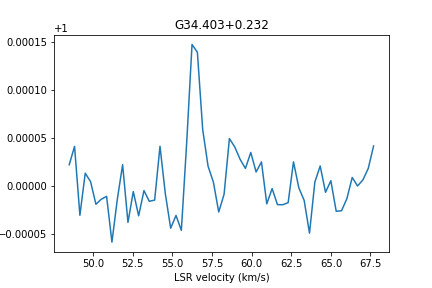
To unsubscribe from this group and all its topics, send an email to sara-list+...@googlegroups.com.
To view this discussion on the web visit https://groups.google.com/d/msgid/sara-list/e6a6d9c6-6381-b11d-d484-0eddd3043f53%40ameritech.net.
Job Geheniau
Eduard Mol
To unsubscribe from this group and stop receiving emails from it, send an email to sara-list+...@googlegroups.com.
To view this discussion on the web visit https://groups.google.com/d/msgid/sara-list/40806fa7-ce5f-4340-adca-7afb543101d4n%40googlegroups.com.
Anthony
To view this discussion on the web visit https://groups.google.com/d/msgid/sara-list/CAFcm1Q4KBabiP%3DgQ2tPZS318SrA4UnD445k976ge0R4OV9RDgw%40mail.gmail.com.
Eduard Mol
To view this discussion on the web visit https://groups.google.com/d/msgid/sara-list/CAKU65Two--1Lx4TyyDK0WseGvH9JNqofr2GUYKYb7kHQT161gw%40mail.gmail.com.
Dimitry UA3AVR
Eduard Mol
djl
good stuff!
To view this discussion on the web visit https://groups.google.com/d/msgid/sara-list/CAFcm1Q5R0-RjLNMfbL%2BJsR_xJ%3DAj4XQd7D_wNTtPOnHeifhi7Q%40mail.gmail.com.
"It's always something."
Roseanne Rosannadanna
----------------------"
Dr. Don Latham AJ7LL
PO Box 404, Frenchtown, MT, 59834
VOX: 406-626-4304
Dimitry Fedorov
To view this discussion on the web visit https://groups.google.com/d/msgid/sara-list/78282eed8834ae1ea323b62c87b6cacf%40montana.com.
Anthony
To view this discussion on the web visit https://groups.google.com/d/msgid/sara-list/78282eed8834ae1ea323b62c87b6cacf%40montana.com.



